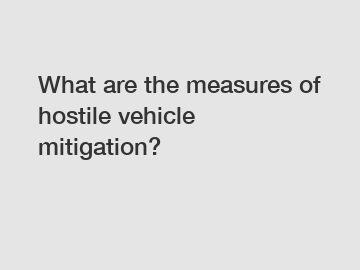What are the measures of hostile vehicle mitigation?
What are the measures of hostile vehicle mitigation?
1. Understanding the threat of hostile vehicle attacks.
In recent years, the world has witnessed an unfortunate rise in hostile vehicle attacks, where individuals use vehicles as weapons to cause harm and destruction. These attacks can occur in public spaces, such as crowded streets, pedestrian zones, or even outdoor events. It has become vital for authorities and organizations to implement effective measures to mitigate the risks associated with such incidents.

2. Physical barriers and bollards.
One of the primary measures of hostile vehicle mitigation is the installation of physical barriers and bollards. These structures are designed to physically prevent vehicles from accessing certain areas or to provide protection to vulnerable spaces. Depending on the level of threat, the barriers can range from simple bollards to more robust systems capable of stopping a high-speed truck. By strategically placing these barriers, areas prone to attacks can be safeguarded effectively.
3. Vehicle access control systems.
Another key measure in hostile vehicle mitigation is the implementation of vehicle access control systems. These systems use advanced technology to regulate and monitor vehicle access to certain locations. Examples of such systems include automatic license plate recognition (ALPR) cameras, boom gates, and biometric authentication. By having control over who can enter specific areas, the risks associated with hostile vehicle attacks can be significantly reduced.
4. Public awareness campaigns and education.
While physical barriers and access control systems are crucial, public awareness campaigns and education play a vital role in hostile vehicle mitigation. By educating the general public about the risks, signs, and preventive measures, individuals can become more vigilant and proactive in identifying and reporting suspicious activities. Moreover, public awareness campaigns can help create a sense of community responsibility, fostering an environment where everyone works together to ensure safety.
5. Collaborative security efforts.
Mitigating hostile vehicle attacks requires collaboration between various stakeholders, including law enforcement agencies, government bodies, private organizations, and the general public. By sharing information, coordinating efforts, and conducting joint exercises, a unified approach can be established to identify potential threats and implement adequate countermeasures. This collaborative approach enhances response capabilities and effectively decreases the likelihood of successful hostile vehicle attacks.
6. Technological solutions.
Advancements in technology have also facilitated the development of innovative solutions for hostile vehicle mitigation. For instance, intelligent video analytics can be utilized to automatically detect suspicious behavior, such as vehicles attempting to breach restricted areas or deviating from regular traffic patterns. Additionally, emerging technologies like autonomous security robots can be deployed to patrol and monitor vulnerable locations, augmenting human security personnel. By harnessing technology, security measures can become more efficient and adaptable to evolving threats.
7. Evaluation and continuous improvement.
Hostile vehicle mitigation is an ongoing process that necessitates regular evaluation and continuous improvement of the implemented measures. Authorities must continuously assess the effectiveness of existing strategies and adapt them to changing threat landscapes. By closely monitoring the latest developments in attack methods and analyzing past incidents, security professionals can refine their approach and address any loopholes or vulnerabilities in the mitigation measures.
In conclusion, hostile vehicle attacks pose a serious threat to public safety. Mitigating these risks requires a multi-faceted approach, encompassing physical barriers, access control systems, awareness campaigns, collaborative security efforts, technological solutions, and continuous improvement. By implementing these measures, authorities and organizations can create safer environments and protect individuals from the devastating consequences of hostile vehicle attacks. However, it is crucial to recognize that security measures alone may not guarantee complete prevention, and ongoing vigilance and adaptability are essential in the face of this evolving threat.
For more information, please visit Automatic Rising Bollards, Semi-automatic Bollards Supplier, Road Blockers.
36
0
0

Comments
All Comments (0)